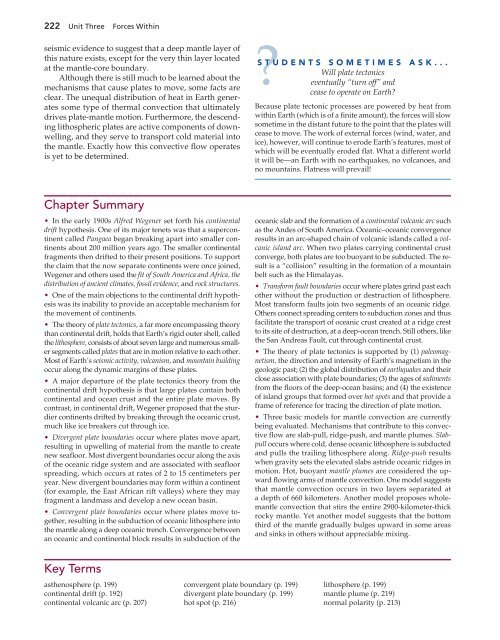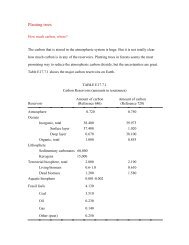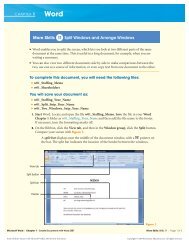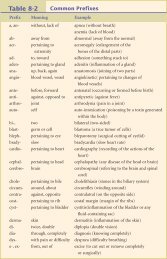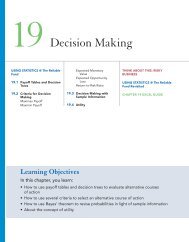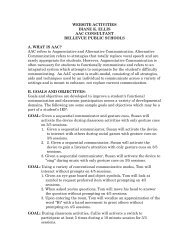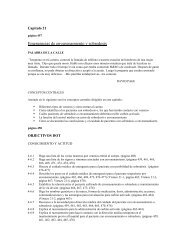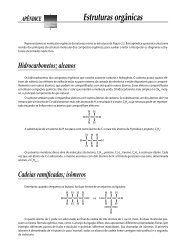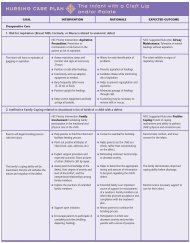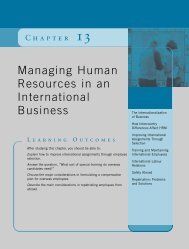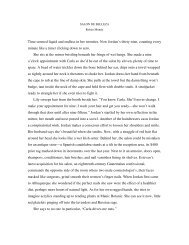chapter
chapter
chapter
Create successful ePaper yourself
Turn your PDF publications into a flip-book with our unique Google optimized e-Paper software.
222 Unit Three Forces Within<br />
seismic evidence to suggest that a deep mantle layer of<br />
this nature exists, except for the very thin layer located<br />
at the mantle-core boundary.<br />
Although there is still much to be learned about the<br />
mechanisms that cause plates to move, some facts are<br />
clear. The unequal distribution of heat in Earth generates<br />
some type of thermal convection that ultimately<br />
drives plate-mantle motion. Furthermore, the descending<br />
lithospheric plates are active components of downwelling,<br />
and they serve to transport cold material into<br />
the mantle. Exactly how this convective flow operates<br />
is yet to be determined.<br />
Chapter Summary<br />
• In the early 1900s Alfred Wegener set forth his continental<br />
drift hypothesis. One of its major tenets was that a supercontinent<br />
called Pangaea began breaking apart into smaller continents<br />
about 200 million years ago. The smaller continental<br />
fragments then drifted to their present positions. To support<br />
the claim that the now separate continents were once joined,<br />
Wegener and others used the fit of South America and Africa, the<br />
distribution of ancient climates, fossil evidence, and rock structures.<br />
• One of the main objections to the continental drift hypothesis<br />
was its inability to provide an acceptable mechanism for<br />
the movement of continents.<br />
• The theory of plate tectonics, a far more encompassing theory<br />
than continental drift, holds that Earth’s rigid outer shell, called<br />
the lithosphere, consists of about seven large and numerous smaller<br />
segments called plates that are in motion relative to each other.<br />
Most of Earth’s seismic activity, volcanism, and mountain building<br />
occur along the dynamic margins of these plates.<br />
• A major departure of the plate tectonics theory from the<br />
continental drift hypothesis is that large plates contain both<br />
continental and ocean crust and the entire plate moves. By<br />
contrast, in continental drift, Wegener proposed that the sturdier<br />
continents drifted by breaking through the oceanic crust,<br />
much like ice breakers cut through ice.<br />
• Divergent plate boundaries occur where plates move apart,<br />
resulting in upwelling of material from the mantle to create<br />
new seafloor. Most divergent boundaries occur along the axis<br />
of the oceanic ridge system and are associated with seafloor<br />
spreading, which occurs at rates of 2 to 15 centimeters per<br />
year. New divergent boundaries may form within a continent<br />
(for example, the East African rift valleys) where they may<br />
fragment a landmass and develop a new ocean basin.<br />
• Convergent plate boundaries occur where plates move together,<br />
resulting in the subduction of oceanic lithosphere into<br />
the mantle along a deep oceanic trench. Convergence between<br />
an oceanic and continental block results in subduction of the<br />
Key Terms<br />
asthenosphere (p. 199)<br />
continental drift (p. 192)<br />
continental volcanic arc (p. 207)<br />
convergent plate boundary (p. 199)<br />
divergent plate boundary (p. 199)<br />
hot spot (p. 216)<br />
?S TUDENTS SOMETIMES ASK...<br />
Will plate tectonics<br />
eventually “turn off” and<br />
cease to operate on Earth?<br />
Because plate tectonic processes are powered by heat from<br />
within Earth (which is of a finite amount), the forces will slow<br />
sometime in the distant future to the point that the plates will<br />
cease to move. The work of external forces (wind, water, and<br />
ice), however, will continue to erode Earth’s features, most of<br />
which will be eventually eroded flat. What a different world<br />
it will be—an Earth with no earthquakes, no volcanoes, and<br />
no mountains. Flatness will prevail!<br />
oceanic slab and the formation of a continental volcanic arc such<br />
as the Andes of South America. Oceanic–oceanic convergence<br />
results in an arc-shaped chain of volcanic islands called a volcanic<br />
island arc. When two plates carrying continental crust<br />
converge, both plates are too buoyant to be subducted. The result<br />
is a “collision” resulting in the formation of a mountain<br />
belt such as the Himalayas.<br />
• Transform fault boundaries occur where plates grind past each<br />
other without the production or destruction of lithosphere.<br />
Most transform faults join two segments of an oceanic ridge.<br />
Others connect spreading centers to subduction zones and thus<br />
facilitate the transport of oceanic crust created at a ridge crest<br />
to its site of destruction, at a deep-ocean trench. Still others, like<br />
the San Andreas Fault, cut through continental crust.<br />
• The theory of plate tectonics is supported by (1) paleomagnetism,<br />
the direction and intensity of Earth’s magnetism in the<br />
geologic past; (2) the global distribution of earthquakes and their<br />
close association with plate boundaries; (3) the ages of sediments<br />
from the floors of the deep-ocean basins; and (4) the existence<br />
of island groups that formed over hot spots and that provide a<br />
frame of reference for tracing the direction of plate motion.<br />
• Three basic models for mantle convection are currently<br />
being evaluated. Mechanisms that contribute to this convective<br />
flow are slab-pull, ridge-push, and mantle plumes. Slabpull<br />
occurs where cold, dense oceanic lithosphere is subducted<br />
and pulls the trailing lithosphere along. Ridge-push results<br />
when gravity sets the elevated slabs astride oceanic ridges in<br />
motion. Hot, buoyant mantle plumes are considered the upward<br />
flowing arms of mantle convection. One model suggests<br />
that mantle convection occurs in two layers separated at<br />
a depth of 660 kilometers. Another model proposes wholemantle<br />
convection that stirs the entire 2900-kilometer-thick<br />
rocky mantle. Yet another model suggests that the bottom<br />
third of the mantle gradually bulges upward in some areas<br />
and sinks in others without appreciable mixing.<br />
lithosphere (p. 199)<br />
mantle plume (p. 219)<br />
normal polarity (p. 213)


